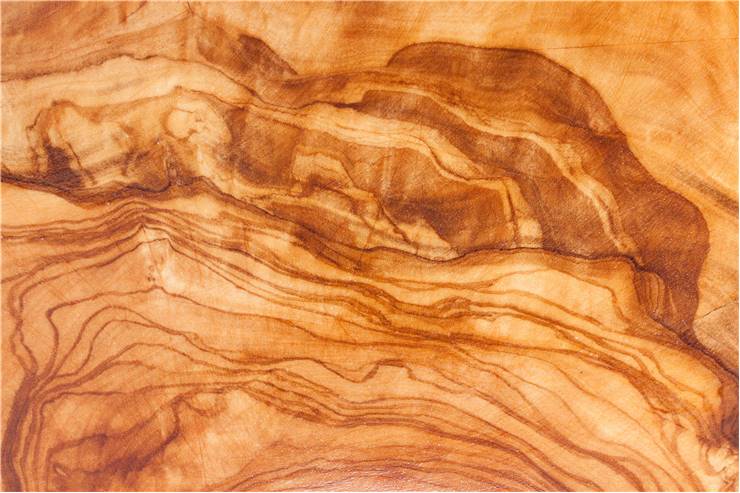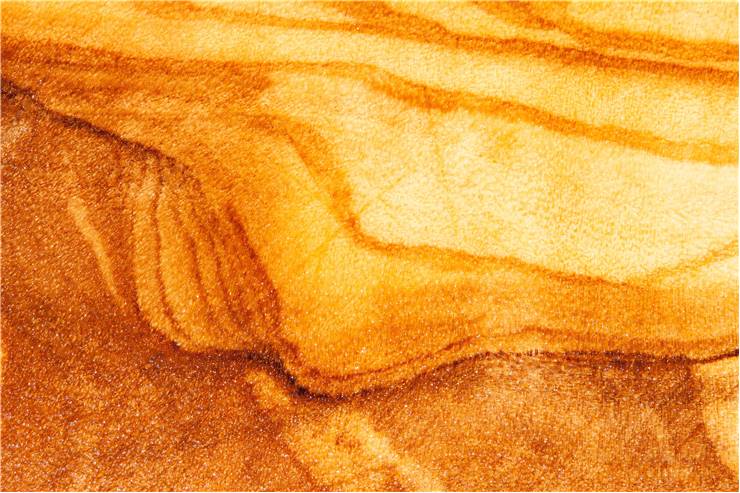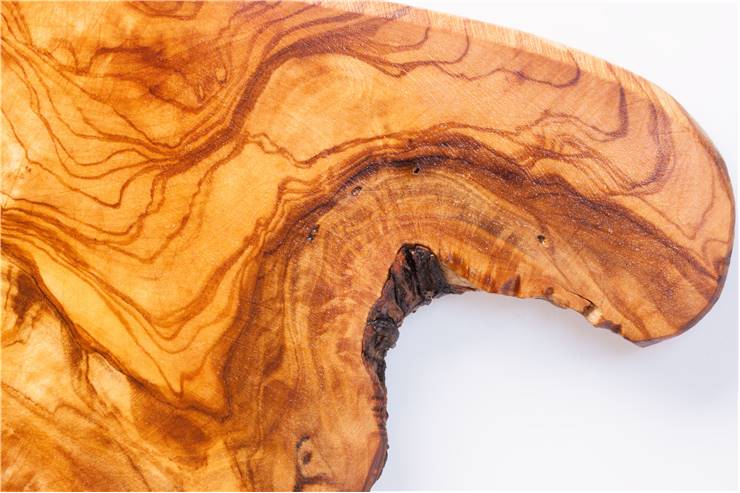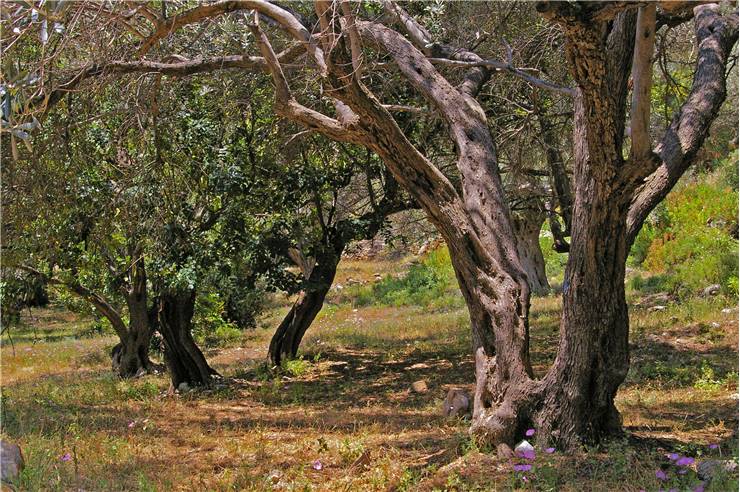Olive Wood - Characteristics, Uses and Benefits
The olive wood, farmed from the trees of Olea europaea, is a hard and rich in color wood that is prized all around the world for its appearance, density, straight grain, and fine texture. Originally found around the eastern coast of the Mediterranean, Olive trees managed to spread outside of Europe, thanks not to the need for wood exploitation but to the growth of its delicious olive fruit that demands very little upkeep and attention during seasonal growth. The most recent reports claim that the olive tree is currently being commercially farmed for its fruit in over 20 countries, with 60% of all trees being located on the territory of the European Union (with five leading countries being Spain, Italy, Turkey, Greece, and Syria).
Olive lumber is very strong, but it has a high sensitivity to outside elements and insect attacks. Because of this, it can commonly be found only in indoor furniture and smaller wooden objects. Visually, olive wood is famous all around the world for its consistent texture, grain, and very distinct and fruity scent when being worked.
Since it has lower durability and resistance to elements and is not therefore used for mass production of flooring, paneling, and structural construction, and has spread around the world where it is planted anywhere where it can grow in hot and dry environments, olive wood is currently not intensely exploited for lumber on the worldwide market. This helped it to remain unlisted on the IUCN Red List of Threatened Species.
What is Olive Wood
Olive wood is wood harvested from Olea europaea and O. capensis, two types of Olive trees originating from southern and eastern Mediterranean countries in Europe and Eastern Africa. Even though Olive trees can live exceptionally long and grow up to 40 meters (130 ft) in height, such occurrences are rare, and the vast majority of trees grow up to 10 meters (33 ft) with 1-1.5 meters trunk diameter.
While olive trees are praised around the world for their fruit, their lumber has also managed to capture the attention of the worldwide woodworking community, who has found great uses for this hard, heavy, dense, and very strong type of wood.
Olive usually grows in a very twisted and irregular way, with a large number of side branches twisting the trunk in many directions, which makes extracting large and straight pieces of lumber difficult. Most lumber extracted from grown Olive trees is cut into smaller pieces. It is used to create smaller indoor objects, with the largest usually being table-top panels or structural objects in furniture.
Visually, olive wood has a strikingly rich and colorful appearance, which makes it perfect for use in decorative objects. Its structural features are highly contrasting brown lines and yellow streaks of sapwood, and even more importantly, the surface of olive wood can be easily polished to a high degree. While it can be a bit uncooperating during cutting, olive wood can easily be glued. It has a distinct, pleasant, and sweet odor during cutting, and this odor usually remains present in the finished product for several years.
The negative point of this wood is that lacks necessary natural oils that repel insects and rot. To achieve more extended durability, furniture made from olive wood needs to be treated so it can remain untouched by outside elements for years. Additionally, raw olive wood is hard to dry, and during this process, the lumber pieces can start to warp. To prevent this, olive wood must be very slowly dried using the Kiln-drying process at low heat levels.
Origin
Olive trees are closely connected with the earliest records of our history, with records confirming that this tree became commercially cultivated in the territories of Crete and ancient Syria more than five thousand years ago. And even before commercial cultivation, olives were used in our ancestor's diets on the territories of Egypt, Create, Greece, Macedonia, Italy, Spain, and others. The oldest surviving records of olive leaves were found on the Greek Island of Santorini, dated to 60 thousand years old.
With such a rich history, olive trees, fruit, and olive oil became integral parts of many surviving ancient texts, art, and artifacts. Olive branches were found in the tomb of Egyptian pharaoh Tutankhamun, ancient Israel, where olive oil, branches, and lumber were mentioned numerous times in the Bible, often as a symbol of peace, wisdom, glory, fertility, power, and purity. Ancient Greece had a close connection with Olive trees and oil, while in Ancient Rome, olive fruit was an essential part of the Roman diet. Olive trees and oil were also mentioned several times in Quran.
The oldest surviving olive tree is disputed, with several candidates being found across the Mediterranean and other territories across the world. The olive tree on the island of Brijuni (Brioni),Istria in Croatia, has confirmed the age of around 1600 years, one west Athens tree is aged at 2,400 years until it was uprooted in 1975 in a traffic accident. One Crete tree is estimated to be over 2 thousand years old, and some trees in Italy and Lebanon are claimed to be over 3 thousand years old.
The oldest certified olive tree is aged 2000 years. It is located in Greece, and it still bears fruit. An average lifespan of an olive tree is between 300 and 600 years.
Characteristics
- Tree size - 25-50 ft (8-15 m) tall
- Trunk diameter - 3-5 ft (1.0-1.5 m)
- Janka Hardness - 2,700 lbf (12,010 N)
- Average Dried Weight - 62 lbs/ft3 (990 kg/m3)
- Specific Gravity (Basic, 12% MC) - .72, .99
- Crushing Strength - 11,180 lbf/in2 (77.1 MPa)
- Modulus of Rupture - 22,530 lbf/in2 (155.4 MPa)
- Elastic Modulus - 2,577,000 lbf/in2 (17.77 GPa)
- Shrinkage - Radial: 5.4%, Tangential: 8.8%, Volumetric: 14.4%, T/R Ratio: 1.6
- Odor - Fruity, distinct and strong scent while working. Enduring odor for several years while polished.
- Workability - Easy to mild, with interlocked grain resulting in possible tear outs during surface operations. Sometimes lumber can have poor stability. It can be glued and finished well.
- Texture - Uniform and fine texture, with some moderate natural luster.
- Grain - Wild, straight, or interlocked grain.
- Sustainability - Not listed on the IUCN Red List of Threatened Species.
- Required growth density - No particular requirements. Olive trees require very little upkeep, but they are slow to reach full size.
- Drying - Slow and hard. It can wrap during fast drying.
- Durability - Medium. It can reach a good age in indoor environments, especially if treated with preservation oils. Untreated olive wood is susceptible to insect and rot attacks.
- Maintenance - Low
- Price - Higher than most lumber types
Uses
Olive wood is versatile and easy to work with, but even though it is hard and strong, it is not used for outdoor applications since it cannot survive in the open for long. It is very rarely available for purchase in the lumber form factor.
However, it is excellent for indoor use, and therefore it can easily be found in these kinds of objects:
- Indoor furniture (especially high-end)
- Turned objects
- Veneer
- Various small specialty wood items
- High-end knife or tool handles
- Art objects
- Small decorative items
- Carvings
- Flooring and paneling (in rare cases)
Types
Olea europaea - Traditional olive tree originating from the eastern Mediterranean, Syria, parts of Asia Minor, the Southern end of the Caspian Sea, and northern Iran. It is best known for its versatile wood and tasteful olive fruit, which can be processed into a popular type of oil. Its branches are celebrated as the symbol of peace.
Olea capensis - African tree of the Olive family, known under the name black ironwood, ironwood, East African olive, and Elgon olive. It grows all across the territory of Sub-Saharan Africa and has three subspecies (macrocarpa, capensis, and enervis)
Benefits
The benefits of the olive tree are numerous. For starters, its fruit has remained in high demand for several millennia, both for direct consumption and for creating a popular type of oil. Direct eating of the olive fruit is rare. Most eat it only after it is processed, reducing the fruit's bitterness.
The olive is also known for its medicinal uses. Many home remedies use olive to calm the user, enhance sleep, boost the immune system, and reduce cholesterol levels in the blood. Olive oil is also promoted to be good for regulating the circulation of fat in the body and boosting the health of the cardiovascular system.
Olive wood is regarded as high-end and is used predominantly to create smaller, more stylish wooden objects or manufacture expensive furniture.



